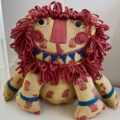shot Apr 16, 2005, 2:25 mins
music: The Animals
Now that the weather’s finally getting warmer, we figured the turtles could spend time outside, so we bought some low fencing (intended to demarcate flowerbeds or something) and planted it in the garden. The enclosure didn’t need to be very high – turtles don’t jump, after all…
(later)
We seem to have solved the problem. I turned around the fencing so that the horizontal bars are on the outside, and the turtles are faced with tall (to them), smooth vertical bars on the inside. They still try to escape, but not nearly so hard, and they seem to have gotten the hang of just relaxing in the sun (there’s a plastic tub set up as a shelter for them to crawl under when they get too hot). I’m still looking for the right size and shape of ceramic planter to use as a pond for them. In the meantime, I put down one of those things you put under a plant pot to catch overflow (sottovaso – undervase – in Italian; what’s the word for that in English?). It’s just low enough for them to crawl over the rim, and they both immediately plunged in. Apparently they get thirsty quickly in the sun.
I was contemplating getting an iguana as a pet, til I read that they live 20 years and can get to be 6 feet long; I don’t feature me at age 62 trying to walk a six-foot lizard. Maybe we’ll get a python instead…






